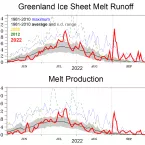Our Research
As climate changes, how do Earth's frozen areas affect our planet and impact society?
In this section
Related News & Stories
Filter by:

Spotlight
On December 10, 1972, the world of sea ice data changed forever. For the first time in history, as the Electrically Scanning Microwave Radiometer (ESMR) launched aboard the NASA Nimbus-5 satellite, scientists gained the ability to track changes in sea ice cover over the Polar Regions every day via passive microwave data. Today, they can piece together a half century’s worth of data from several instruments and satellite missions, including ESMR, to better understand how global warming is affecting Arctic and Antarctic sea ice.
Analysis - Sea Ice Today
November’s rate of sea ice growth in the Arctic was near average. Several of the peripheral seas have open water areas late into the autumn season. Warm air temperatures persist in the northern North Atlantic and northwestern Europe.

Analysis - Ice Sheets Today
While most of the 2022 Greenland melt season was near average, September set records for high temperatures, melt extent, and ice loss.

Feature Story
Through partnerships with community members and vital climate information recorded by volunteers in local observer networks, NSIDC's Arctic Rain on Snow Study (AROSS) aims to better understand rain on snow events and other winter precipitation changes—with a focus on how they impact peoples in the Arctic.

ELOKA Spotlight
Under the ELOKA program, funded by the National Science Foundation (NSF), principal investigators Noor Johnson and Matthew Druckenmiller recognized the potential to train and build the capacity of students.